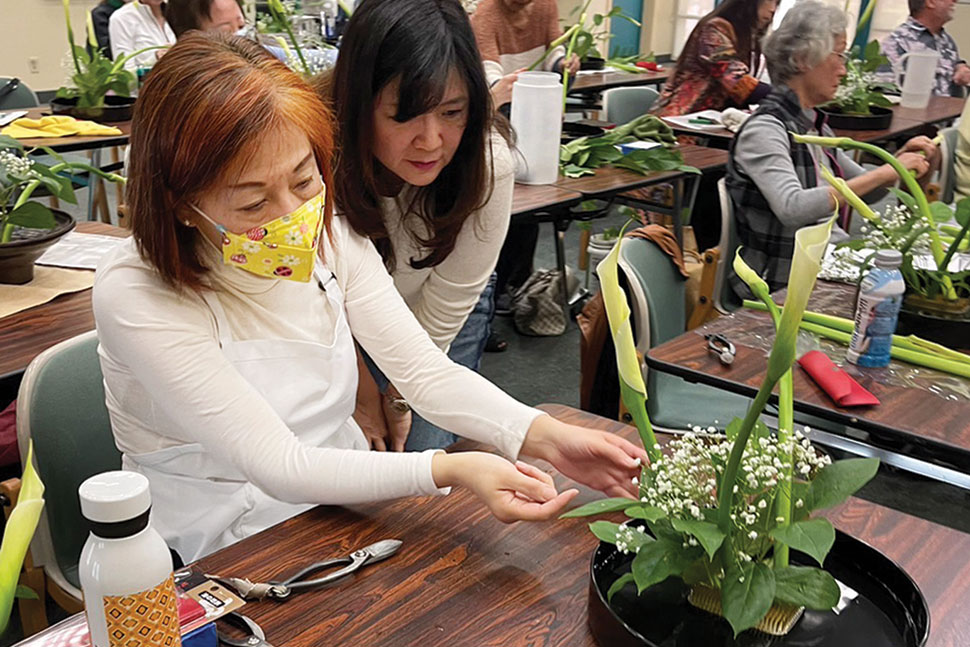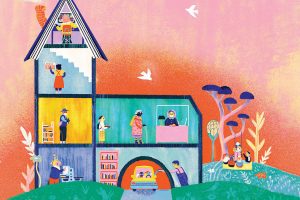
Ikebana—the ancient Japanese art of flower arranging—is finding new fans among library patrons. Through online and in-person workshops and exhibitions, many participants find that it brings them a welcome sense of relief and calm, as well as new skills.
“People who come are fully engaged in the process,” says Matt Beatty, branch manager at San Diego Public Library’s Scripps Miramar Ranch Library (SMRL).
More than simply decorative, ikebana is about noticing and appreciating the beauty of nature and bringing the indoors and outdoors together. Using principles of minimalism, silence, shape, and line, practitioners select living branches, flowers, leaves, and other natural elements to create expressive arrangements.
A display of community
At SMRL, certified ikebana instructor Huimei Lai teaches the art form in weekly classes to adults 55 and older. The program, which charges patrons a small fee for floral materials, is offered through the San Diego College of Continuing Education’s Emeritus Program.
Lai has taught the course at the library for two semesters and consistently has a full house. The oldest student recently celebrated her 90th birthday. “We share happy things, as well as sadness,” she says. For example, when one student received a cancer diagnosis and stopped coming, Lai encouraged them to return. Once back, she saw their emotional transformation as a result of being in a supportive and social environment. “The class has become like a community,” she says.
For each workshop, Lai brings flowers, leaves, and branches that she divides among the class. Students bring their own kenzan (similar to a flower frog, or pin holder), vases, and floral clippers. Lai starts with a brief lecture, reviews materials, and does a demo. Then students make their arrangements and she provides feedback.
The art form helps students work on manual dexterity and express their creative side, says Beatty. “Because it’s hands-on,” he says, “it works well for people who may have problems hearing straightforward lectures.”
Another plus, Beatty notes, are the mental health benefits. “People have a greater feeling of isolation than they did prepandemic,” he says. “There’s been a shift in outlook. People look at programming now as a way to meet up with others more than they did before.”
Slowing down
Roxanne Ringer, assistant branch manager at Kingstowne Library and former youth services manager at Great Falls Library (GFL)—both part of Fairfax County (Va.) Public Library—hosted an ikebana program for kids at GFL in 2019.
The program was done in collaboration with the Great Falls Garden Club. For the event, club members dressed up as flowers, did a demo, and provided worksheets on the rules of ikebana.
Ringer says that while a lot of children’s programs are fast paced, this was different. “The kids slowed down and listened and were very conscientious about how they placed their flowers,” she says.
The meditative atmosphere encouraged imaginative thinking skills, Ringer recalls. “It created thoughtfulness in the room,” she says. “I think it was the calmest program I’ve ever done.”
‘A joyful effect’
For 15 years, Boulder (Colo.) Public Library (BPL) and the state chapter of the Ikenobo Ikebana Society of America (IISA) have partnered to host an annual, two-day ikebana exhibition, featuring work by practitioners from all over the Boulder area. Sponsored by the Boulder Arts Council, the juried show is one of the library’s most popular annual events, drawing more than 5,600 people last fall.
“Last year in particular, people enjoyed just being out—it felt like getting back to normal,” says Dan Dell’Agnese, president of IISA’s Colorado chapter, who has organized the exhibition since its founding. “It was a very uplifting experience.”
Jennifer Lord, library specialist at BPL, has a 4th-grade certificate in Sogetsu ikebana, a style of ikebana that promotes free expression. Lord says looking at the arrangements is very healing for the spirit.
“It’s a pretty magical experience,” they say. “You go into a room and look at beautiful flowers, and they’re presented in a way to show their living qualities and highlight their beauty. That definitely has a calming, joyful effect.”
Culturally meaningful
In June 2021, during the pandemic, Vicki Heck, adult services librarian at Newcastle branch in King County (Wash.) Library System, hosted a virtual introduction to ikebana.
Of the estimated 100 people who signed up, about 90 attended, “which was unusual,” she says. In her experience, typically only half of registrants show up for virtual programs.
The event grew out of her library’s partnership with Newcastle Arts Council. The area, just outside of Seattle, has a large Asian American population, and Heck wanted to find a culturally meaningful program to offer residents.
She called upon Sogetsu-certified ikebana teacher Fanny Yau to conduct the virtual program. Yau provided a list of supplies for attendees to round up beforehand. Because students collected their own floral materials, their arrangements were particularly unique.
The program allowed people to learn a new skill, Heck points out—something they may not have had time to do before COVID-19.
“Having a library open to providing all kinds of different programs, about all different kinds of cultures, helps open up the mind of the entire community,” Heck says. “They are a great way for us to relate our audiences back to the library collection, so they can continue to learn more on their own.”


